Language of the Soul – Mudra in Buddhist Art
PRIMITIVE - Friday, December 12, 2014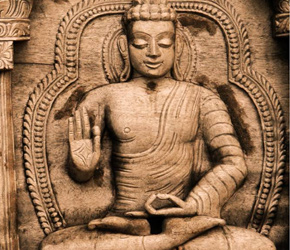 |
|
By Misaki Imagawa
If eyes are windows into the soul, then hands must be its voice. It’s amazing how expressive hands can be and how we use them to communicate. Have you ever caught yourself talking on the phone and waving your hands in exaggeration even though your gestures are invisible to the person or people on the other side? Or have you ever been so stuck on words that nothing comes out of your mouth, but you find yourself gesturing with your hands because they know what you want to say? Hand expressions are powerful tools of communication that humankind appears to have always utilized; so much so that today, entire languages are spoken through non-verbal gestures.
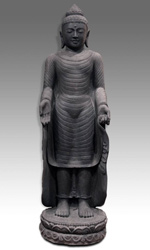 |
|
the Varada mudra; PRIMITIVE ID# A0901-188 |
|
Even outside the realm of sign language, hand motions are fundamental in communication by everyone everyday all other the world. Yet, not all gestures are universal. I once tried to invite someone over by stretching my hand out, palm down, and curling my fingers inward a few times. That’s a common ‘come here’ gesture in Japan. Yet, to someone who grew up in Western culture it looked like I was gesturing the ‘shoo,’ or ‘go away’ sign. Needless to say, there was some explaining to do when the person I was inviting turned away offended. Likewise, a thumbs-up may mean ‘ok’ or ‘good’ in Western culture, while in others like Iran, Thailand or Bangladesh; it’s the equivalent of “flipping the bird.” So if you find yourself in one of these countries with your mouth full of delicious food and the waiter asks how everything is going; just remember, anything but thumbs-up.
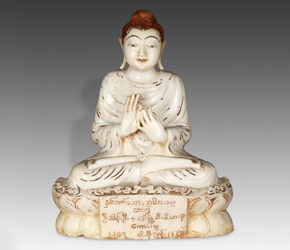 |
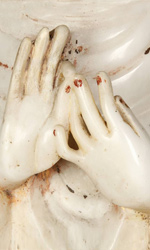 |
|
The ‘go away’ or ‘come here’ gestures and the thumbs-up are relatively modern developments. Hand gestures in general have been around for millennia and immortalized in art. In Buddhist art, this manifests itself in the form of mudras – the hand and finger positions of Buddhas and Bodhisattvas, or ‘enlightened ones.’ If you look at enough Buddhist sculptures you can’t help but notice the various and ever-changing positions of their hands, which are not random whims of the artist. Much like stained glass in churches, mudras are ways to indicate the nature and function of deities in a simple, visual language intended to be understood by all. Mudras hold special meanings and commemorate moments of importance in the historical life of Buddha.
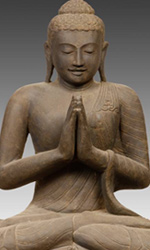 |
|
PRIMITIVE ID# A0910-180 |
|
Though there are many mudras with fascinating meanings and stories. Here are several of the most common ones:
The Dharmachakra mudra is the gesture of teaching; it was used by the historical Gautama Buddha when he gave his first sermon after reaching enlightenment, one of the most important moments in the life of Buddha. It is said that this was the moment when he set into motion the Wheel of Dharma, the literal translation of dharmachakra, a Sanskrit word.
In this mudra, thumb and index finger touch at their tips to form a circle. The circle represents the Wheel of Dharma.
The Dhyana mudra is the gesture of meditation. Both hands rest on the lap with palms facing up – not the stereotypical pose of the hands on both knees and the thumb and index fingers curled into circles. This mudra is also known as Buddha’s mudra, and is said to radiate perfect balance of the senses and the mind.
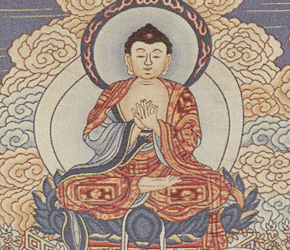 |
|
The Abhaya mudra is the gesture of fearlessness, most often expressed with the right hand while the left forms another mudra called Varada, the gesture of compassion. The abhaya mudra looks like the gesture meaning “stop.” The hand is held upright, typically at shoulder height, palm outward. It is said that a malevolent being once turned a maddened elephant on Gautama Buddha, trying to kill him; but Buddha, by displaying the gesture of Abhaya, calmed the beast.
In the Varada mudra, the hand is held downwards with fingers and thumb pointing the same way, palm facing outward from the body. This is the mudra associated with any sort of blessing.
The Namaskar mudra is the gesture of prayer. In this gesture, the hands are kept close to the chest in devotional attitude with the palms and fingers joined pointing upward. It is also considered a greeting of the utmost respect.
The mudra called Vitarka is the gesture representing the transmission and conveyance of Buddha’s teachings. This mudra implies a discussion of Buddha’s teachings and allows for disagreement. Consequently, it is also called the gesture of argument. The mudra is formed by joining the tip of the thumb and index finger while keeping the fingers straight. It is very similar to the Dharmachakra mudra, which usually involves two hands.
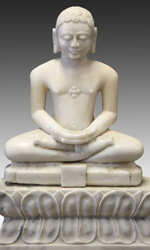 |
|
PRIMITIVE ID# A0901-075 |
|
Lastly, there is the Bhumisparsha mudra, the symbol of “calling the earth to witness.” In this mudra the right hand is held downward over the knee, pointing toward the ground or the earth. The story behind it is enlightening unto itself. As Gautama meditated under the Bodhi tree, the demon king Mara tried to frighten him with a horde of soldiers and when that didn’t work, tried to tempt him away with his daughters. When that too failed, Mara claimed enlightenment for himself and his minions shouted that they were his witnesses. Mara then challenged Gautama, asking him for his witness. The former prince lowered his right hand and with his fingers touched the earth. This is the posture of the Bhumisparsha mudra. The Earth roared, “I bear you witness!” and the demon king fled. As the morning star rose that day, Gautama reached enlightenment. This mudra also represents Buddha’s perseverance in pursuing enlightenment as well as the conquest of evil.
Sometimes gestures and silence prove to be more powerful than spoken words. Knowing the meaning behind mudras brings a whole new dimension to viewing Buddhist art. The language goes beyond the external history of the artworks and delves deeper, ultimately speaking to inner resolves. Perhaps that is why over time mudras were incorporated into Indian classical dance where the meaning of the song is expressed solely through hand movements. Mudras also made their way into yoga practices where they were considered seals of energy. Therefore, there are several meanings associated with the word ‘mudra,’ which has no singular translation. Mudra can mean ‘seal’, ‘gesture’, ‘attitude’ or even ‘authority’. In the end, there is nothing random about the gestures known as mudras. They convey stories and meaning - providing a compelling, silent language straight from the soul.
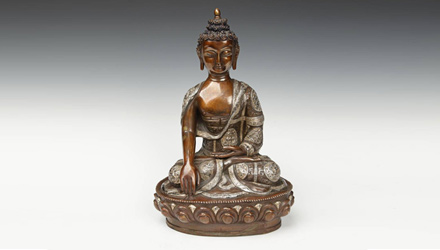 |
Download this Article: Language of the Soul.pdf